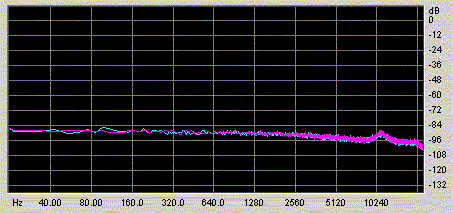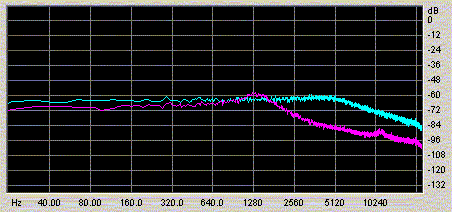Since quite a few people have built the Doede DAC 1543. I was wondering if you could state your preference for reclocked or not and what each topologies's strengths and or weaknesses are. If you like maybe even a picture..so I could put up a page with Doede's dacs implementions.
Regards,
Bas
My reclocking does not work yet ...so unfortunately I can't contribute myself.
Regards,
Bas
My reclocking does not work yet ...so unfortunately I can't contribute myself.
I use reclocking (Elso's ASR) and it definitely makes a difference, absolutely in better....
I think it is really worth a try.
Cheers
Andrea
I think it is really worth a try.
Cheers
Andrea
Hi Bas,
Me and my brother have built two almost identical DDDAC1543 which lets us compare reclocking vs. no reclocking.
This DAC sounds great without, but even better with reclocking.
See http://www.geocities.com/tdac1543 for some more info and a lot of pictuers. I wouldn't mind to find some of them on a DDDAC1543 gallery. 😉
Regards, Fabian
Me and my brother have built two almost identical DDDAC1543 which lets us compare reclocking vs. no reclocking.
This DAC sounds great without, but even better with reclocking.
See http://www.geocities.com/tdac1543 for some more info and a lot of pictuers. I wouldn't mind to find some of them on a DDDAC1543 gallery. 😉
Regards, Fabian
Bas Horneman said:Since quite a few people have built the Doede DAC 1543. I was wondering if you could state your preference for reclocked or not and what each topologies's strengths and or weaknesses are. If you like maybe even a picture..so I could put up a page with Doede's dacs implementions.
Regards,
Bas
My reclocking does not work yet ...so unfortunately I can't contribute myself.
Hi
My suggestion does not fit with the cheap and simple design target, but improving the XO supply (lower noise) does even sound better.......
regards
Hi Fabian,
Thanks! Your implementation looks great and I would be glad to put them up there. However I am without a pc at home at the moment so it will take a while.
Regards,
Bas
Not trying to steal every trick in your book but a battery supply fed to tl431 regulator -> supplying a little ferrite choke -> decoupled with another little 22uF cap...how much better does it need to be and how much better can it get?
Regards,
Bas
I wouldn't mind to find some of them on a DDDAC1543 gallery.
Thanks! Your implementation looks great and I would be glad to put them up there. However I am without a pc at home at the moment so it will take a while.
Regards,
Bas
Hi Guido,but improving the XO supply (lower noise) does even sound better.......
Not trying to steal every trick in your book but a battery supply fed to tl431 regulator -> supplying a little ferrite choke -> decoupled with another little 22uF cap...how much better does it need to be and how much better can it get?
Regards,
Bas
Bas Horneman said:
Hi Guido,
Not trying to steal every trick in your book but a battery supply fed to tl431 regulator -> supplying a little ferrite choke -> decoupled with another little 22uF cap...how much better does it need to be and how much better can it get?
Regards,
Bas
Hi Bas
Go for the lowest noise you can get. Have you ever measured the TL431 implementation ?
If you want I can measure here at my lab. My own reg is below 5nV/SqrrtHz
regards
Konnichiwa,
I have not measured it, but Werner Ogiers has measured it. The Noisefloor appears to be around 90db below a stated 21mV as "0db".

http://www.tnt-audio.com/clinica/regulators_noise3_e.html
If used for a 5V supply and without bypassing the Adj pin to the Anode you get a 6db worse noise level (-84db). Given that such a noisefloor is a lot better than a similar part count LM317/337 (and LT/LM1085 et al) it is definitly worth it. A basic LM317 (337 in pink) Supply is a lot noisier at around -66db (a 18db difference).

In other words, the unweighted RMS noisefloor of a correctly applied TL431 will be around 15uV noise and one for 5V without the Adj bypass around 30uV (in a 20KHz bandwidth).
This suggests in the 20KHz range around 0.7uV RMS noise. That is between 26 and 32db better. However, is such a reduction in noise over the TL431 translates into an equal improvement in sound as that of the TL431 over generic 3-Pin regs is a totally different story. Below certain levels I do not feel that regulator self noise is a material issue, for 16-Bit digital audio the noise treshold is not THAT low.
If you want really low noise very simple than use an RC filtered Zenner (may even be a TL431 which has nicely low noise) into a low noise BJT darlington without any feedback (aka Kwack Regulator), if that sort of performance is needed for a 16-Bit DAC with no oversampling would have to be tested to be determined.
Sayonara
Guido Tent said:Go for the lowest noise you can get. Have you ever measured the TL431 implementation ?
I have not measured it, but Werner Ogiers has measured it. The Noisefloor appears to be around 90db below a stated 21mV as "0db".

http://www.tnt-audio.com/clinica/regulators_noise3_e.html
If used for a 5V supply and without bypassing the Adj pin to the Anode you get a 6db worse noise level (-84db). Given that such a noisefloor is a lot better than a similar part count LM317/337 (and LT/LM1085 et al) it is definitly worth it. A basic LM317 (337 in pink) Supply is a lot noisier at around -66db (a 18db difference).

In other words, the unweighted RMS noisefloor of a correctly applied TL431 will be around 15uV noise and one for 5V without the Adj bypass around 30uV (in a 20KHz bandwidth).
Guido Tent said:My own reg is below 5nV/SqrrtHz
This suggests in the 20KHz range around 0.7uV RMS noise. That is between 26 and 32db better. However, is such a reduction in noise over the TL431 translates into an equal improvement in sound as that of the TL431 over generic 3-Pin regs is a totally different story. Below certain levels I do not feel that regulator self noise is a material issue, for 16-Bit digital audio the noise treshold is not THAT low.
If you want really low noise very simple than use an RC filtered Zenner (may even be a TL431 which has nicely low noise) into a low noise BJT darlington without any feedback (aka Kwack Regulator), if that sort of performance is needed for a 16-Bit DAC with no oversampling would have to be tested to be determined.
Sayonara
Konnichiwa,
The formula is the usual time constant.
Assume the two resistors setting the Voltage on the TL431 in parallel (say 1k & 1k for 5V - giving 500R) and choose a capacitor large enough in value to keep the impedance small in comparison to the Resistor. I tend to favour 160000/R for the capacitance in uF, giving a bypass down to around 1Hz, so 330uF looks good.
THAT SAID, if minimising LF noise is not so essential, a 22uF Cap will keep the rise in noise to less than 3db at 15Hz and to nothing at much higher frequencies.
Sayonara
Bricolo said:Thorsten, what cap size should be used on the TL431's adj and output?
The formula is the usual time constant.
Assume the two resistors setting the Voltage on the TL431 in parallel (say 1k & 1k for 5V - giving 500R) and choose a capacitor large enough in value to keep the impedance small in comparison to the Resistor. I tend to favour 160000/R for the capacitance in uF, giving a bypass down to around 1Hz, so 330uF looks good.
THAT SAID, if minimising LF noise is not so essential, a 22uF Cap will keep the rise in noise to less than 3db at 15Hz and to nothing at much higher frequencies.
Sayonara
Kuei Yang Wang said:Konnichiwa,
This suggests in the 20KHz range around 0.7uV RMS noise. That is between 26 and 32db better. However, is such a reduction in noise over the TL431 translates into an equal improvement in sound as that of the TL431 over generic 3-Pin regs is a totally different story. Below certain levels I do not feel that regulator self noise is a material issue, for 16-Bit digital audio the noise treshold is not THAT low..
Sayonara
Hi
The application is feeding a low jitter clock, I still hear improvements in that range, esepecially when taking low frequency noise into account (1/f noise, which is not flat, is also at a very low level in my reg)
Ciao
- Status
- Not open for further replies.
- Home
- Source & Line
- Digital Source
- Doede DAC..reclocked or not?